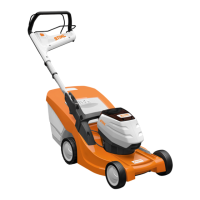0478 131 9940 B - EN
44
– The charger is operative and has not
been modified.
If not in good operating condition,
components can no longer operate
correctly and safety devices may be dis
abled. There is a risk of serious injury to
persons.
● Do not use a damaged or defective
charger. Dispose of the charger.
● If the charger is dirty or wet: clean the
charger and allow it to dry.
● Do not modify the charger.
● Do not insert any objects into the
apertures in the charger.
● Never connect the charger terminals
with metallic objects and cause a short
circuit.
● Do not open the charger.
The electric cable is not intended for
carrying or suspending the charger. The
electric cable and the charger could
become damaged.
● Pick up and hold the charger by the
housing. A recessed grip is provided on
the housing for easy lifting of the
charger.
● Store the charger on the wall bracket.
4.5 Charging
Contact with live components can result
from the following causes:
– The electric cable is damaged.
– The mains plug is damaged.
– The socket is incorrectly installed.
Contact with live components can result in
an electric shock. The user could be
seriously or fatally injured.
● The mains plug and electric cable are
particularly important when it comes to
electrical safety.
● Insert the mains plug in a correctly
installed socket.
An incorrect mains voltage or an incorrect
mains frequency during charging may lead
to overvoltage in the charger. The charger
could become damaged.
● Ensure that the mains voltage and the
mains frequency of the power supply
correspond to the information contained
in the rating plate on the charger.
A damaged or defective charger may emit
a strange odour or smoke. Persons could
be injured or property damaged.
● Remove mains plug from socket.
In the case of insufficient heat dissipation,
the charger could overheat, causing a fire.
Persons could be seriously or fatally
injured and property may be damaged.
● Do not cover the charger.
● Store the charger on the wall bracket.
If several chargers are connected to a
socket, electrical wires could become
overloaded during charging. The electrical
wires could heat up and cause a fire.
Persons could be seriously or fatally
injured and property may be damaged.
● Only connect one charger to a socket.
● Do not connect a charger to multiple
sockets.
4.6 Transporting the machine
Always wear gloves in order to prevent
injuries due to sharp-edged and hot
components.
Switch off the machine prior to
transport, allow the blade to
come to a standstill and remove the safety
plug.
Only transport the machine once the motor
has cooled down.
Take the weight of the machine into
account and use suitable loading aids
(loading ramps, lifters) if necessary.
Secure the machine and any machine
components being transported (e.g. grass
catcher box) on the load floor using
fastening material of adequate size (belts,
ropes, etc.).
Avoid contact with the mowing blade when
lifting and carrying the machine.
Observe the information in the section
"Transport". It describes how to lift and
lash the machine. (Ö 14.)
When transporting the machine, always
observe regional legislation, especially
regarding load security and the transport
of objects on load floors.
4.7 Transporting the battery
The battery is not protected against all
ambient conditions. If exposed to certain
ambient conditions, the battery may
become damaged and property may be
damaged
● Do not transport a damaged battery.
● Transport the battery in the machine, in
electrically non-conductive packaging
or in an electrically non-conductive
transport container.
During transport outside of the machine,
the battery could tip over or move. Persons
could be injured or property damaged.

